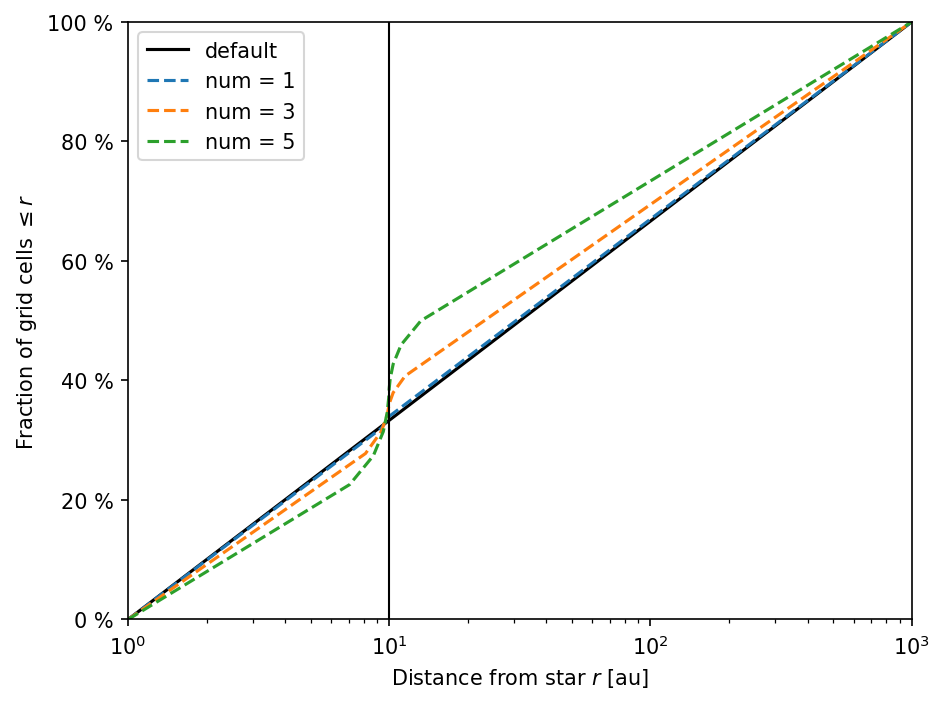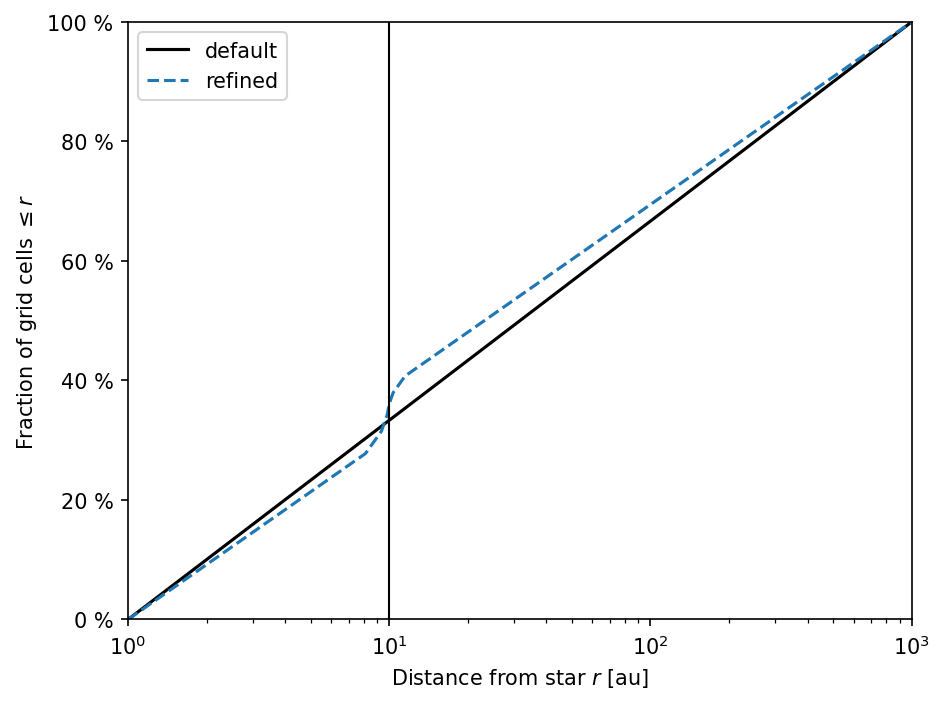Grid refinement
The purpose of this package is to provide simple functions to refine the radial grid around certain locations.
In this example we want to refine the grid at a distance of \(10\,\mathrm{au}\). We first create a DustPy simulation object.
[1]:
from dustpy import Simulation
from dustpy import constants as c
[2]:
r0 = 10. * c.au
[3]:
s = Simulation()
Since we want to provide a custom grid, we do not initialize the simulation object at this point. Instead we create our own grid cell interfaces, which are at this points identical to the default interfaces.
[4]:
import numpy as np
[5]:
ri = np.geomspace(s.ini.grid.rmin, s.ini.grid.rmax, s.ini.grid.Nr)
We can now use the helper function refine_radial_local() to locally refine our grid. We do this for different refinement levels to demonstrate the differences.
[6]:
from dustpylib.grid.refinement import refine_radial_local
[7]:
ri_fine_1 = refine_radial_local(ri, r0, num=1)
ri_fine_3 = refine_radial_local(ri, r0, num=3)
ri_fine_5 = refine_radial_local(ri, r0, num=5)
We can plot the cummulative distribution of grid cell interfaces.
[8]:
import matplotlib.pyplot as plt
plt.rcParams["figure.dpi"] = 150.
[9]:
fig, ax = plt.subplots()
ax.semilogx(ri/c.au, np.linspace(0., 100., ri.shape[0]), label="default", color="black")
ax.semilogx(ri_fine_1/c.au, np.linspace(0., 100., ri_fine_1.shape[0]), "--", label="num = 1")
ax.semilogx(ri_fine_3/c.au, np.linspace(0., 100., ri_fine_3.shape[0]), "--", label="num = 3")
ax.semilogx(ri_fine_5/c.au, np.linspace(0., 100., ri_fine_5.shape[0]), "--", label="num = 5")
ax.axvline(r0/c.au, lw=1, color="black")
ax.set_xlim(ri[0]/c.au, ri[-1]/c.au)
ax.set_ylim(0., 100.)
ax.set_yticks(ax.get_yticks())
ax.set_yticklabels(["{:.0f} %".format(t) for t in ax.get_yticks()])
ax.set_xlabel("Distance from star $r$ [au]")
ax.set_ylabel("Fraction of grid cells $\leq r$")
ax.legend()
fig.tight_layout()

To initialize the model with the new refined grid we have to set the radial grid cell interfaces before initialization.
[10]:
s.grid.ri = ri_fine_3
[11]:
s.initialize()
The model can now be run with the new grid with su.run().
[12]:
fig, ax = plt.subplots()
ax.semilogx(ri/c.au, np.linspace(0., 100., ri.shape[0]), label="default", color="black")
ax.semilogx(s.grid.ri/c.au, np.linspace(0., 100., s.grid.ri.shape[0]), "--", label="refined")
ax.axvline(r0/c.au, lw=1, color="black")
ax.set_xlim(ri[0]/c.au, ri[-1]/c.au)
ax.set_ylim(0., 100.)
ax.set_yticks(ax.get_yticks())
ax.set_yticklabels(["{:.0f} %".format(t) for t in ax.get_yticks()])
ax.set_xlabel("Distance from star $r$ [au]")
ax.set_ylabel("Fraction of grid cells $\leq r$")
ax.legend()
fig.tight_layout()
